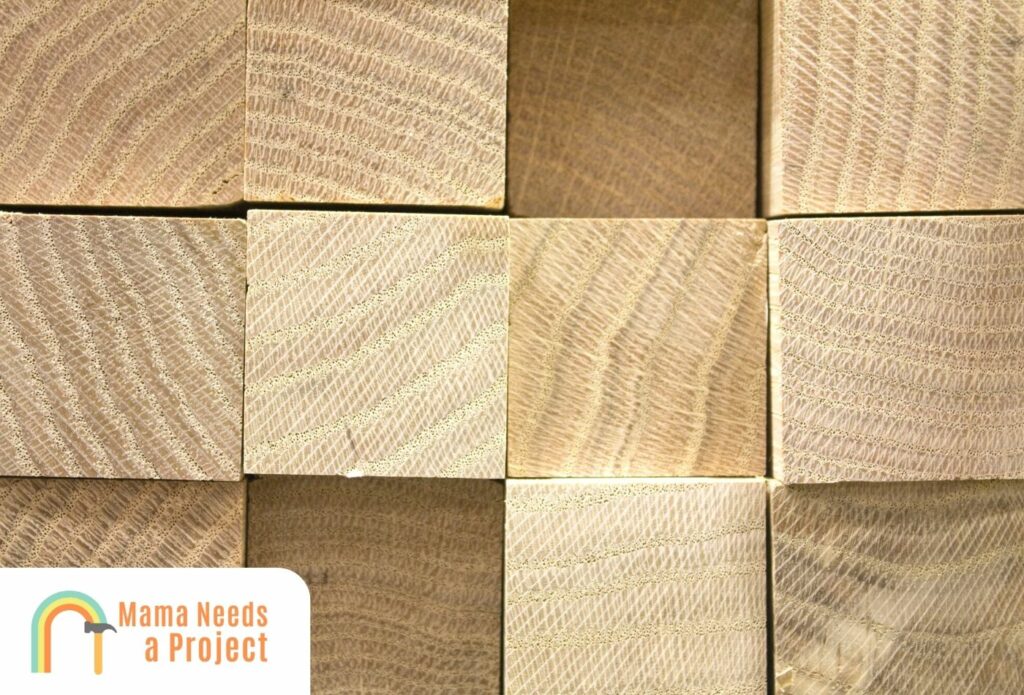How Much Weight can a 4×4 Hold? (Complete Guide)
Wood comes in many shapes and sizes, and one of the most commonly used boards is the 4×4.
In this post, I’ll discuss everything you need to know about a standard 4×4’s weight capacity, and I also explain the handful of key factors which determine how much weight a 4×4 can support. Let’s begin!
- Horizontally, a 4×4 can bear up to 500 lbs of centralized weight and up to 1,000 lbs of evenly distributed weight. As a vertical support, a 4×4 can bear upwards of 4,300 lbs.
- Several factors collectively determine how much weight a 4×4 can safely support, including wood type, wood grade, dimensions, grain orientation, moisture content, and condition.
How Much Weight Can a 4×4 Hold Horizontally?
Generally speaking, 4x4s laid horizontally don’t support as much weight as 4x4s in a vertical position. That said, horizontal 4x4s still have significant load-bearing capacity.
At one time, 4x4s were frequently used as headers, beams, and wall plates, but such isn’t the case anymore because there are more efficient options nowadays.
Regardless, how much weight 4x4s can support horizontally is still important, not just for building purposes but for safety reasons too.
In most cases, an 8-foot 4×4 that’s supported at both ends can support up to 500 lbs in the center.
As far as evenly distributed weight goes, most 4x4s can support up to 1,000 pounds of evenly distributed weight.
And if the 4×4 is reinforced, it should be able to support up to 4,000 pounds of evenly distributed weight.
You can also check out this guide to understand how much weight a 2×4 can hold and how much weight a 2×6 can hold!
How Much Weight Can a 4×4 Hold Vertically?

4x4s are often used as posts since they can support thousands of pounds in this position.
Most 4×4 posts can support at least 4,300 lbs, and some can even support up to 23,000 lbs (if properly spaced and other conditions are met).
Basically, the shorter a post is, the more weight it can support. So a row of 3-foot 4x4s can collectively support up to 17,000 lbs, whereas a row of 10-foot 4x4s could only bear 4,300 lbs.
According to the International Residential Building Code (IRC-2022), 4×4 deck posts should not exceed 6’-9” in height.
What Is the Compressive Strength of a 4×4?
The term “compressive strength” refers to how much weight a piece of wood, in this case a 4×4, can support in an upright position without failing.
No. 2 SPF 4x4x4s, for example, have a compressive strength of 14,477 lbs, whereas 4x4x10s have a compressive strength of 3,858 lbs.
How Much Weight Can a Pressure-Treated 4×4 Hold?
Pressure-treated 4x4s don’t have more load-bearing capacity than untreated 4x4s; both boards have virtually the same load capacity.
Pressure treatment only makes a 4×4 more resistant to the elements; it has no bearing on the maximum weight a 4×4 can support.
That said, while it’s true pressure-treated 4x4s and untreated 4x4s have the same load-bearing capacity, pressure-treated wood can retain its load-bearing capacity longer, since it doesn’t wear down as quickly.
It goes without saying, but when a board weakens over time, it can’t support as much weight as before, and it’ll be more prone to sagging or failing.
So if you’re going to be using 4×4 beams or posts outdoors, it’s best to go with pressure-treated wood, as this material can hold significant weight for a long period, even if it’s subjected to the elements routinely.
What Affects the Load Capacity of a 4×4?
Wood Species
One of the most important factors when it comes to how much weight a 4×4 can support is wood species.
Some wood species, particularly hardwoods like yellow pine and oak, can hold more weight than others.
That said, plenty of softwoods—like spruce pine-fir and hemlock fir—are used often for a range of construction projects because they’re cheaper and more workable yet remarkably sturdy.
Various factors determine which kind of wood is best for a construction project, but the amount of weight the wood will have to support is definitely one of the most important factors to consider when selecting wood.
Wood Grade
Wood grade is another important factor to consider. All wood is graded 1-5, with the sturdiest, most construction-worthy pieces having a grade of 1-2.
Wood that’s 3-5 grade should be passed over if you’re looking for 4x4s that are capable of bearing a significant amount of weight.
Most building codes call for high-grade wood at the structural level because it’s built to last and able to withstand a lot over the years.
Note: Different species have different grades, meaning some mid-grade hardwoods may resemble some higher-grade softwoods (in terms of durability and workability).
Dimensions
The size of the 4×4, particularly its span, is important too.
Essentially, the longer the span, the more prone the piece will be to failing; this is the case whether the board is laid horizontally or placed upright.
Grain Orientation
The orientation of the grain is relevant as well, since pressure that’s applied parallel to the grain is easier to absorb than pressure that’s applied perpendicular to the grain, i.e. when a 4×4 is laid horizontally.
Many softwoods get much of their strength from their pronounced grains.
Moisture Content
The amount of moisture a wood naturally retains is relevant here as well.
Woods with high moisture content are generally less sturdy then drier woods, and hardwoods tend to be less moist than softwoods, in large part because they’re denser.
That said, hardwood that’s exposed to the elements, especially if it’s not treated, can eventually retain a lot of moisture and become weaker as a result.
Condition
Of course, the wood’s condition also plays a big role in determining how much weight a 4×4 can bear.
Take a vertical support, for example. If it’s weak in the midsection, it’ll be more prone to buckling, in which case it’s a safety hazard.
On the other hand, a horizontal piece of kiln-dried lumber is likely to be in great condition and therefore able to support considerable weight over many years.
Type & Location of Load
The type of load the 4×4 has to support, as well as the location of the load, plays a significant role in determining how much total weight the 4 x 4 can support.
For example, dead load that’s centralized is more likely to cause sagging because it puts sustained pressure on the weakest part of the 4×4.
On the other hand, a 4×4 that has to sporadically support evenly distributed live weight will rarely be under significant stress and is likely to hold up for a longer period of time.
What to Look For When Buying a 4×4
Imperfections
Wood that’s rife with imperfections should be avoided if you’re looking for 4x4s that can support considerable weight.
Knots, gouges, cracks, etc. can make wood less sound and therefore less secure.
Essentially, wood that has a lot of imperfections, i.e. low-grade wood, is more likely to completely fail when subjected to too much weight.
High-grade wood is virtually free of imperfections and capable of providing proper support both indoors and outdoors.
Rings
Wood that comes from the outer part of the tree is known as edge wood, and it’s stronger than wood that comes from the center of the tree (heartwood).
One way to tell the difference between edge wood and heartwood is by examining the rings on the wood. If they’re flatter and less pronounced, it’s probably edge wood; pronounced, raised rings indicate heartwood.
Technically, structures can be built out of either wood, but edge wood provides additional support.
Incision Marks
Incision marks are often found on pressure-treated timber since slight incisions are the entryways through which the chemicals enter the inner part of the wood.
Although they’re not as compromising as imperfections, these incisions can make a piece of wood weaker over time.
Therefore, if you need 4x4s that are going to retain their max weight capacity for a considerable period of time, it’s best to get high-grade lumber that’s free of incision marks, as this will hold up better in the long run.
Which 4×4 Is Strongest?
Southern Pine and Douglas-fir-larch are two of the strongest softwoods, and therefore both are often used for construction.
But it’s not just their durability that makes these woods sought-after; they’re also workable and much more affordable (when compared to other wood species).
Plenty of hardwoods will do just fine as support pieces, but because they’re so expensive they’re mostly used for decorative pieces.
When considering which 4×4 material will be best for your project, strength should not be overlooked. Wood’s strength is largely determined by its type and grade, among other factors.
Therefore, if strong 4x4s are what you’re after, look for pieces that have flat rings, as these are probably edge pieces (which tend to be stronger than center pieces).
You should also only use wood that has a limited number of imperfections; pieces that are rife with imperfections are hard to work with, don’t look good, and don’t hold up nearly as long as imperfection-free pieces.
Are 4x4s Used as Floor Joists?
Back in the day, 4x4s were often used as floor joists. Now, however, metallic and concrete beams are preferred, since they last longer and can support more weight.
And if you need supportive wood pieces to serve as floor joists, it’s best to choose paired 2x4s over regular 4x4s, as paired 2x4s can support much more weight when turned on their edge.
If you have to use 4x4s as floor joists, refrain from having substantial dead load at the center of these boards, as this can cause sagging and may eventually lead to a full-blown failure.
It’s also wise to use vertical supports 16 inches apart so the beams are well supported; space 12 inches apart for even greater stability.
How Far Can a 4×4 Span Without Sagging?
A 4×4 can span several feet before sagging.
However, 4×4 beams that are meant to support constant weight are never used without necessary vertical supports, so it’s rare to find a 4×4 with a long, unsupported span.
Even if you use vertical supports every 16 inches, it’s wise to refrain from using a 4×4 with a span larger than eight feet, as a board of this length will sag with or without support.
How far a 4×4 can span without sagging is collectively determined by the factors discussed already, but load, wood type, and grade are the most important factors by far.
Because they eventually sag even with support, 4x4s are no longer used frequently as beams, as materials like metal and concrete are stronger and can ensure much larger spans.
Are Two 2x4s Stronger Than One 4×4?
If paired 2x4s are resting on their edge, it’s likely they can support more weight than a standard 4×4.
That said, if the paired boards are made of weaker material, it’s likely the regular 4×4 will have more weight capacity.
When paired 2x4s are laid flat (horizontal), they’re not as strong as horizontal 4x4s, mainly because 4x4s are denser, solid pieces. Vertically, 4x4s are stronger too.
And when it comes to pairing 2x4s, the adhesion needs to be solid, otherwise the finished product won’t be able to safely support the weight that’s put on it.
Final Thoughts
To recap, how much weight a 4×4 can hold is mainly determined by its position.
Specifically, if it’s laid vertically, it can support up to 500 lbs of centralized weight, and up to 1,000 lbs of evenly distributed weight.
Standing upright, a 4×4 can support upwards of 4,300 lbs, provided there are multiple, properly spaced 4x4s.
Also, how much weight a 4×4 can hold is influenced by the species, the grade, the dimensions, the grain, moisture content, and condition.

